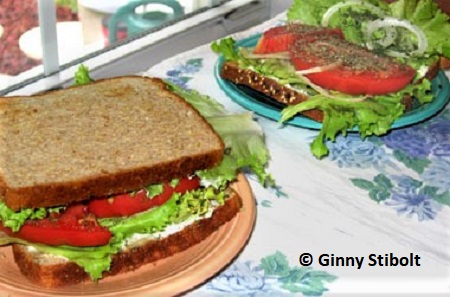Adventures of a Transplanted Gardener |
|||||||
Tomatoes are for summer!
| |||||||
|
|
One of my favorite summer treats is eating tomatoes fresh from the garden—a fat tomato sandwich makes a great lunch. It gives me a good feeling because we've controlled all the steps from the seed to the table. We call this sandwich a OLT (Onion, Lettuce, and Tomato) on toasted multi-grained bread with lettuce on both sides of the sandwich to keep the juicy tomatoes from soaking the toast. Yummy.
Tomato information:
-
Botanists classify the tomato (Lycopersicon esculentum) as a fruit (a berry to be precise), but in 1893 the United States Supreme Court declared the tomato to be a vegetable! It was all about import tariffs for vegetables, but not for fruits.
-
Tomatoes contain an abundance of lycopene, a formidable cancer fighting chemical compound—the redder the fruit, the higher the amount. It's been shown that both cooking tomatoes and eating them with small amount of fat helps improve the body's absorption of lycopene. Using this as an excuse, maybe we don't need to feel guilty when we slather the mayonnaise on our tomato sandwiches.
-
Tomatoes are native to the Andes Mountains in South America. They were imported into the US via Europe.
-
Many of the tomato's relatives are poisonous such as deadly nightshade and tobacco. Tomatoes themselves were thought to be poisonous by Europeans during the Age of Discovery, so they were grown as only decorative plants and were known as the “love apple." Many relatives are also crops such as peppers, eggplants, and potatoes. (I once judged a science fair project where a student grafted the top of a tomato plant with the bottom of a potato plant—just above the soil line. What a crop that would be! I gave him high marks for his project.)
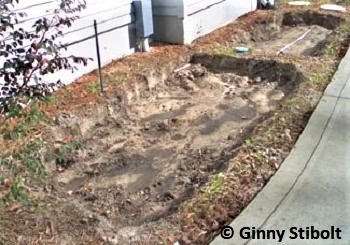 |
Last year's crop was on the puny side
<< Last year we left most of the sandy soil in place and put some topsoil and dried cow manure from a bag, under each plant: the crop was just okay. After harvesting the last of the tomatoes, my husband and I dug out the soil in that bed right down to the sprinkler system's pipes. We lined the bottom of the bed with leaves, and compost from our compost pile and left it for the winter. Then a month or so before our tomatoes were ready to plant, we filled the beds with a mixture of approximately 50% horse manure (from a neighbor), 30% compost, and 20% of that sandy soil we'd removed.
We let it sit for a month while the seedlings were getting a start in small containers. By then, the beds were full of weeds, of course. We removed the weeds before we planted our tomato seedlings.
Last year we'd made the mistake of planting determinate tomatoes that stopped producing well before the end of our long growing season. This year we planted three types of tomatoes: Sweet 100 cherry tomatoes, Early Girls, and Brandy Boys. All of these are indeterminate, so they should continue to produce until frost. We'll see what happens, because the late summer heat here can be pretty brutal for some plants.
(Update: I was wrong here, because I had not yet adjusted to Florida tomato seasons where most tomatoes stop setting fruit when the low nighttime temperatures are higher than 70 degrees and that our wet summers cause most tomatoes to get a fungal wilt disease. Also, today I would not recommend any double digging, but just building new, rich soil on top of the ground.)
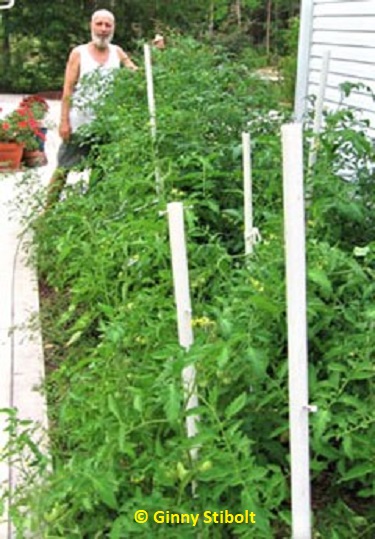 |
This year's tomatoes are more robust so far...
This year, after the total soil replacement with our mixture of compost and horse manure, we could see a big improvement in our seedlings' growth very soon after we planted them.
This photo (taken the middle of May) shows vigorous growth
>>
of all three types of tomatoes. They were all blooming and the
bees were buzzing around them full-time. A week or so after this photo,
all three varieties started ripening at the same time. I found that
interesting:
I guess the Early Girls aren't that much earlier in this climate.
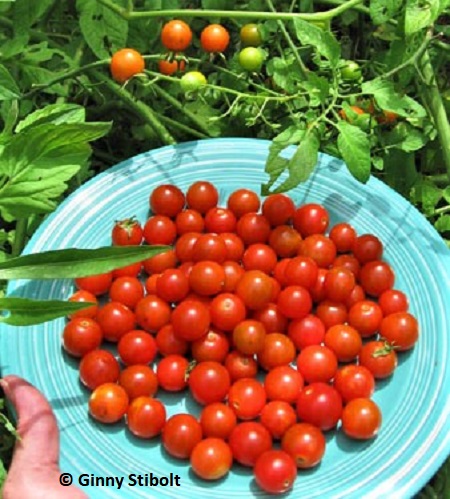 |
The Sweet 100s
Burpee's description:
"Tomato Super Sweet 100 Hybrid (Cherry) Scarlet, cherry-sized fruits are produced in long clusters right up to frost. 70 days. Bursting with sugary flavor. Scarlet, cherry-sized fruits are produced in long clusters right up to frost. Grow on stakes or fence. Indeterminate"
<< Sweet 100s are our longtime favorites. As advertised, they produce lots and lots of perfect, sweet tomatoes that may be best right off the vine. They are wonderful in salads and just right for dipping in our favorite tomato dip.
They do tend to split if they aren't picked in time. Gosh, we are then forced to eat them right there in the garden.
Brandy Boys
Burpee's description:
"Tomato Brandy Boy Hybrid A huge pink beefsteak with incredible heirloom flavor and very high yields. Only Burpee could improve a classic. Many gardeners consider Brandywine heirloom tomato to be the best tasting of all tomatoes. But as all tomato connoisseurs know, Brandywine has its drawbacks. The tomatoes are often misshapen with uneven shoulder ripening. The plants grow wildly, set fruit late in the summer and yield a sparse crop at best. But not Brandy Boy! Our new hybrid Brandywine produces loads of large pink fruits, up to 5½ inches across, that ripen evenly, with soft heirloom texture, thin skin and that same incredible Brandywine flavor. Better yet the plants sport an upright more manageable growth habit. Brandy Boy is an indeterminate variety, ready to pick 75-78 days after setting out plants. If you love tomatoes like we do, and especially the rich, tangy-sweet taste of Brandywine, don't miss Brandy Boy! Indeterminate."
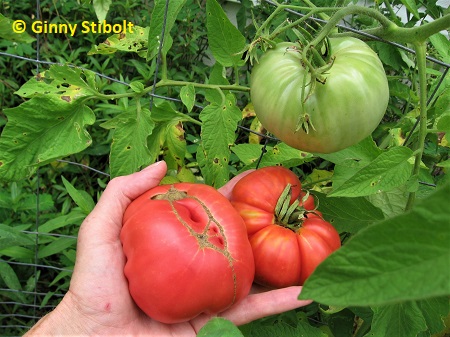 |
Burpee's long description explains some of the history, but I found that this was the first successful hybrid tomato offered to home gardeners by Burpee in 1948! The leaves of this variety are less divided than other tomatoes we've grown: some people call them potato-leaf tomatoes.
So far this season, they've been cracking at the top.
>>
Some say that cracking is due to irregular watering and that
correct mulching will prevent it. I'm not sure about that, because we've
programmed our sprinkler system to water twice a week unless it rains
and we've composted the soil very well. Brandy Boys are also
susceptible to "catfacing", deformities at the blossom end
of the fruit. Some say that it's due to cool weather or poor pollination.
Here in north Florida, neither is a problem, but we have catfacing anyway.
The Brandy Boys' color is duskier and pinker (less orange) with a tinge
of purple. So far this season, most of the bunches on the Brandy Boy
plants produce just one or two fruits. These are the ones that we use
for our tomato sandwiches. Delicious, deformed or not.
The Early Girls
Burpee's description:
"Tomato Early Girl Hybrid Bears heavy crops extremely early, continues longer than most varieties. 59 days. Large clusters of 5 oz. fruits. Globe to slightly flattened shape. Bright red and meaty with a lot of flavor and aroma. Indeterminate."
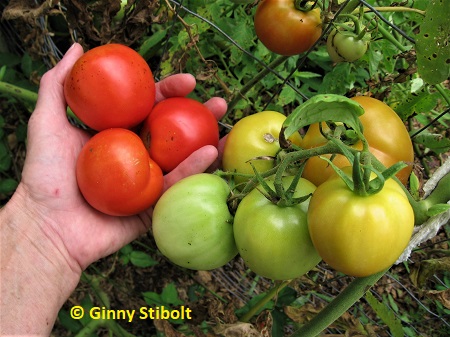 |
<< Early Girls were introduced in 1975 in response to demand for more production in a short season with chilly nights. We'll see how they do with our long, hot summer. In comparison to the Brandy Boys so far this season, they are smaller (2" to 3"), more globular, and tend to be better looking. When sliced, the Early Girls have less meat and more juice. The taste is wonderful but different from the Brandy Boys—I'd say they are a little sweeter. So far this season, they have produced more tomatoes than the Brandy Boys, but not nearly as many as the Sweet 100s.
We are also growing bell peppers and herbs, including basil—a must, in my opinion, to accompany all those tomatoes. We like these crops because they require very little care once they get going.
I've shared bags of tomatoes with our neighbor with the horses in return for the manure and with a new neighbor as a welcoming gift. I hope you have arranged your summer so that you may sit back and enjoy the fruits (or is it vegetables?) of your labor.
(Update: This photo of my left hand and the Early Girl tomatoes graced the cover of "Organic Methods for Vegetable Gardening in Florida."
Ginny Stibolt is a life-long gardener, a botanist, a naturalist, and a garden writer. You may contact her or read more of her articles posted on her website: www.greengardeningmatters.com.
Copyright Ginny Stibolt


